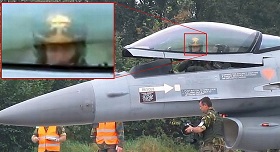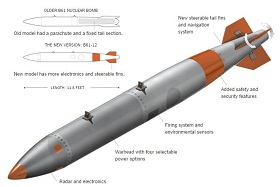Rifle Hanging on the Wall
Inert B61-12 bomb
In
Login if you are already registered
(votes: 3, rating: 5) |
(3 votes) |
Research Fellow at the Primakov Institute of World Economy and International Relations under the Russian Academy of Sciences, RIAC expert
The US tactical nuclear weapons in Europe draw the attention of the Russian media and politicians on a regular basis — they refer to them as a major instability factor and example of Washington’s aggressive nature. Apparently, the sharpening of contradictions between Russia and NATO will kindle even more interest in this issue. The modernization of the US arsenal that started “at a bad time” seems to have added fuel to the flame.
US tactical nuclear weapons in Europe
The US tactical nuclear weapons in Europe draw the attention of the Russian media and politicians on a regular basis — they refer to them as a major instability factor and example of Washington’s aggressive nature. Apparently, the sharpening of contradictions between Russia and NATO will kindle even more interest in this issue. The modernization of the US arsenal that started “at a bad time” seems to have added fuel to the flame.
Who put the rifle on the wall
There is no generally accepted definition of “tactical nuclear weapons” (TNW). TNW are designed for use in the course of combat operations in order to produce a direct impact on battlefield engagement. Unlike strategic nuclear weapons, TNW are not designed and often cannot be used for engaging targets deep in the enemy territory, including industrial clusters, transport hubs, inhabited areas, and command posts of military and political leaders. The typical TNW targets are front-line airfields, major groups of enemy troops, and fortified localities. From the perspective of the military art dating from the Cold War, worthy targets for nuclear weapons included major ships, armor teams, artillery squadrons, submarines, and even enemy aircraft.
The typical TNW targets are front-line airfields, major groups of enemy troops, and fortified localities.

Mark 7 Thor nuclear bomb
Powerful engineering thought with unlimited resources has brought about a variety of TNW that are way more diverse than strategic nuclear weapons [1]. Delivery vehicles for nuclear munitions include torpedoes, depth bombs, artillery shells, mines, surface-to-air missiles, air-to-air missiles, light recoilless rifles, and humans [2].
Nuclear weapons could have debuted as a means to directly impact combat activities in the course of Operation Downfall, the plan for the invasion of the main islands of the Japanese Empire. From 7 to 15 bombs could have been used to engage fortified localities and groups of troops. Fortunately for both sides, Japan surrendered before the bombs were used. After the end of World War II, nuclear weapons were developed primarily for striking industrial, military, and political clusters deep in the enemy territory. Increased production rates and reduction in the weight and dimensions of weapons encouraged the idea of “battlefield” nuclear weapons. The Korean War generously contributed to TNW development.
No wonder TNW were coming into the operation of the US troops in Europe — the main hypothetic combat theater of World War III — as soon as they were produced. In the summer of 1952, the 20th Fighter-Bomber Wing of the US Air Forces was deployed in the United Kingdom. The Republic F-84 Thunderjet fighter bomber armed with state-of-the-art Mark 7 Thor nuclear bomb [3] became the first TNW deployed in Europe.
In late 1953, the M65 280 mm Atomic Cannon [4] capable of firing a nuclear device entered the inventory of the US Army in Europe. The following year the first MGR-1 Honest John nuclear-capable surface-to-surface missiles were added to the US arsenal in Europe [5]. They had comparable range and capability, but were a lot easier to operate and more mobile. A few years later, those first systems were replaced with all-new weapons: MGM-5 Corporal nuclear missiles [6], F-100 Super Sabre and F-101 Voodoo supersonic jet fighter aircraft. Regular caliber cannon artillery units were now capable of using nuclear warheads.
Interestingly, TNW were originally designed to be used together with NATO allies. In case of a new war, three M65 battalions were supposed to be delivered to allies — two to Europe’s Northern Group led by the UK, and one to the French army. The MGR-1 system was exported on a large scale, mainly to the European allies. This practice persisted as new delivery vehicles were developed. In all such cases, Americans provided training for allied units and developed joint plans for the use of nuclear weapons while keeping formal control of the munitions that were to be handed over to Europeans after a corresponding order by the US military and political leaders was issued.

MGM-5 Corporal
Of all such arrangements, the most interesting one is Project E, a precursor of the current NATO “combined nuclear forces.” Although the UK managed to become a nuclear power, its inventories of nuclear weapons were meager back in the 1950s. After the US administration adopted a softer approach to nuclear collaboration with the British in 1958, agreements were reached to provide US nuclear bombs to the Royal Air Force. This originally concerned only long-range bomber aircraft based on the British Isles, but almost immediately applied to the Canberra medium bombers deployed in Germany as part of the British Army of the Rhine. TNW delivery aircraft in Europe were so important for the United Kingdom that the Canberra bombers based in Germany were removed from operational use only as late as 1972, when they were replaced with the Jaguar fighter bomber. Canberra bombers were removed from the inventory of conventional units a lot earlier, back at the start of the 1960s.
The NPT reached in 1968 affect neither the allied training practice, including non-nuclear weapons states, nor the readiness to provide them with nuclear weapons once they needed them. The provisions of the NPT were as good as ignored.
By the early 1970s, the number of the US TNW in Europe had reached its peak. In 1971, there were 7,300 nuclear weapons deployed in Europe [8]. The total number of TNW has decreased since then due to arsenal updates; however, their effectiveness has increased.
Great disarmament
To date, this arsenal has been decreased by tens of times thanks largely to the commitment to stockpile most of the TNW and eliminate some of their types initiated by President George H.W. Bush on 27 September 1991 and supported by Presidents of the USSR and Russia Mikhail Gorbachev and Boris Yeltsin [8]. These measures, referred to as the Presidential Nuclear Initiatives (PNIs), are the undeservedly forgotten bright page in the history of mutual weapons limitations and reductions. The reason why those initiatives emerged and proved to be successful was the objective willingness of both sides to get rid of the colossal amounts of TNW accumulated for the impending World War III, which eventually became a crippling useless burden. The elimination of tactical nuclear weapons took many years. It is believed that by 2010, the United States had reduced its arsenal by 90% from 1991, and Russia made a 75% cut in its arsenal [9]. As soon as the two countries reached a comfortable level, efforts to further reduce nuclear stockpiles were discontinued. The fact that Russia has more TNW can be attributed to the need to make up for NATO’s superiority in terms of conventional weapons in Europe and be able to respond to a potential threat from China.
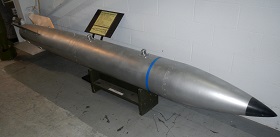
B61 bomb
The exact amount of TNW in possession of the United States and Russia is unknown.
The exact amount of TNW in possession of the United States and Russia is unknown. We can only refer to assessments made by experts, who have little trust in our country because of the high level of secrecy around the nuclear issue. It might seem odd, but the cloak of secrecy regarding tactical nuclear weapons is much thicker than that around strategic nuclear weapons [10].
The implementation of the PNIs envisaged the elimination of nuclear warheads for ground-based tactical missiles, nuclear shells and mines (including portable charges) and stockpiling of nuclear charges for surface-to-air missiles. Naval TNW were also stockpiled and not deployed on ships put to sea [11]. Russia completely moved TNW to its territory [12]. The United States withdrew TNW from South Korea, Japan and most of Europe back during the presidency of George H.W. Bush. However, in 1994, arms cuts slowed, and the challenge of B61 and their joint use by NATO forces emerged. The problem still plagues the relationship between Russia and NATO.
Stumbling bombs
The B61 bomb is the only tactical nuclear weapon remaining in the inventory of the United States. The bomb does not look like a stereotypical nuclear charge — a massive spherical air bomb with a large tail unit [13]. The B61 is a 3.5 m 300 kg cigar-shaped silver bomb (aka the “silver bullet”). Equipped with a parachute and capable of detonating not only at a specified altitude or when touching the ground, but also being set to a timer, it can be used from low altitudes without any threat to the carrier aircraft.
The program to develop a light weight FUFO bomb was initiated in 1961, and quantity production began in 1966. As of today, of the 3,000 bombs of all modifications only approximately 825 of five modifications remain. Of them 370 are deployed at airbases with carrier aircraft [14].
Modern modifications include:
1. Tactical B61-3/4/10 with four yield versions (depending on missions) that can be selected before departure. Maximum yields vary from 50 (B61-4) to 170 (B61-3) kilotons. The minimum yield of all B61 bombs is 0.3 kiloton [15].
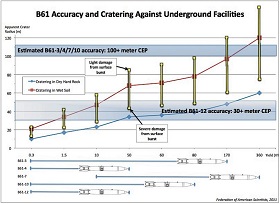
B61 accuracy and cratering against
underground facilities
Russia links the size of its arsenal to NATO’s superiority in conventional weapons.
2. Strategic B61-7 with a higher yield of 10–340 kilotons.
3. Strategic B61-11, a modernized B61-7 designed for engaging protectable underground facilities. Yields were increased to 400 kilotons. The B61-11 is a non-variable yield bomb [16].
The B-2A and B-52H bombers are used to carry the strategic modifications of the B61. Tactical versions were designed to be carried by offensive aircraft used by western countries, including the Tornado, F-15E and F-16 (various modifications).
Nuclear community
US TNW were withdrawn from some countries back during the presidency of George H.W. Bush. His son added to the list Greece and the UK, and most of the “German arsenal” was cut.
An estimated 180 B61-3/4 air bombs are currently deployed at foreign air bases. They are located in the following countries [17]:
- Belgium (Kleine Brogel, 20 units, carriers — F-16A/B of the 10th Tactical Wing of the Air Component of the Belgian Armed Forces [18]);
- Germany (Büchel, 20 units, carriers — Tornado IDS of the Tactical Air Force Wing 33);
- Italy (Aviano, 50 units, carriers — F-16C/D of the 31st Fighter Wing of the United States Air Force [19]; Ghedi, 20 units, carriers — Tornado IDS of the 6th Wing of the Italian Air Force);
- the Netherlands (Volkel, 20 units, carriers — 16A/B of the 312th and 313th squadrons of the Royal Netherlands Air Force);
- Turkey (Incirlik, 50 units, no permanent air force unit [20]).
The vaults at the said bases have a combined capacity of approximately 350 bombs.
The Cold War practices still continue at the bases in Belgium, Germany, Italy, and the Netherlands — bombs are officially under control of the so-called Munitions Support Squadron (MUNSS) of the United States Air Force with normal authorized manning of approximately 125-150 land personnel. Security and guard services are provided by the local personnel. In addition to the maintenance and storage of ammunition, the mission of US specialists includes the training of the local personnel to independently use TNW. In case a major military clash in the European combat theater requires the use of TNW, the US president will authorize the Allied Joint Force commander [21] to use TNW. Nuclear bombs will be loaded on the aircraft carriers (jointly by US and local specialists) and delivered to advanced airfields. Further use of TNW will depend on the design of the allied forces. Attack aircraft armed with nuclear bombs will be supported by the local air forces of Hungary, Greece, Poland, Norway, Romania, and the Czech Republic [22]. Command and staff and practical exercises are routinely conducted to ensure interoperability, for example, Steadfast Noon.
According to the US administration, NPT limitations do not apply to the practice of the joint use of TNW by NATO forces. The following arguments are cited: 1) ammunition will be delivered to the local forces only in case of a major warfare, when such international accords become invalid; 2) in time of peace, US troops “fully control” the nuclear ammunition; 3) US TNW had been brought to European states by 1968, which means status quo will be maintained and no new deployments will be made. These arguments are obviously weak, though.
Dry Powder for the Rifle Hanging on the Wall
Talking about the USA’s violation of at least the NPT’s spirit, it’s worth noting that large-scale reduction of TNW in Europe by the USA is a positive development. However, by the time Barack Obama’s administration came to power, the USA were likely to have achieved the minimum they were not going to give up unless Russia made some essential concessions. According to foreign estimates, the Russian TNW arsenal exceeds 2,000 units [9]. Whether or not these estimates are true, it exceeds the American one to a significant extent.
TNW’s future is closely associated with the general issue of security on the European continent, as Russia links the size of its arsenal to NATO’s superiority in conventional weapons. Besides, it should be taken into consideration that with the reduction of strategic nuclear forces (SNF) TNW gain more significance. The issue of tactical armaments may also arise in negotiating the document to replace the New START.
In the best years of the Russian-American relations one could hope that gradual reduction will continue, powered by irrelevance, economic considerations and the public opinion in European countries. After the beginning of the Ukrainian crisis, these hopes had to be postponed for years in the least. The plans concerning TNW modernization, associated in the first turn with the F-35A Lightning II fifth generation combat aircraft and a new modification of B61 bomb will probably be implemented to a full extent.
Following the removal of F-117A attack aircraft from service in 2008, the US tactical aviation lost a stealth TNW carrier [23]. The situation should be remedied in mid 2020s when first F-35A Block 4B will start entering operational service. It is particularly important that Lightning II will be used not only in the USA, but also in many European countries as a NATO’s TNW carrier among other uses. Italy, the Netherlands, and Turkey are already taking part in the F-35 program; Belgium will probably choose it as a replacement for its F-16. Therefore, all the countries (except Germany) have a prospective carrier. It’s not so clear for the German air force – the use of Tornado aircrafts is possible until mid 2030s at the most (they are scheduled to be removed from operational use in mid 2020s), while the primary fighter – Eurofighter Typhoon – is not a TNW carrier. Germany has recently enhanced its efforts aimed at finding new participants for the joint European program of the Next-Generation Weapon System (NextGenWS). However, this should not be linked to the prospects of storing TNW in Germany, as the USA always can either use the “bombs without planes” scheme (like at Incirlik Air Base) or to move them to Spangdahlem where the aircrafts of the American Air Force are stationed.
In the discussion around the American TNW in Europe, the greatest arguments are triggered by new B61-12 bombs rather than by carriers. In the future 480 bombs of this type will replace all other modifications of B61 [24] – the start of operational use is scheduled for early 2020s. The main difference of these bombs from the previous ones is their tail section patterned after the one used in JDAM bombs, with a guidance system [25] and guided tail fins. Due to modernization, circular error probable is expected to be reduced to 30m [26], which is particularly important for the destruction of fortified underground targets. An increase in precision will make it possible to use the warhead of B61-4 with the smallest yield of up to 50 kt, while 10 kt will be enough for the destruction of most targets, even fortified ones. An increase in precision combined with the reduction of yield will lead to the decrease of collateral damage, thus creating the threat of lowering the TNW application threshold.
It goes without saying that in this case it’s not a conflict with Russia, a country for which SNF command posts are most important underground facilities (a nuclear attack on them will cause an evident reaction, and it would be too late to care about the decrease of collateral damage), but rather a hypothetical local conflict that is worth consideration.
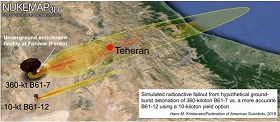
Simulated radioactive fallout from hypothetical
ground-burst detonation of B61-7 vs B61-12
Due to the aggravation of the international situation in the recent years, it’s not worth expecting that the USA will reduce their nuclear weapons. Moreover, a dangerous trend towards the lowering of its application threshold in a local conflict has taken shape. “NATO’s combined nuclear forces” will still be a political instrument, a tangible embodiment of the American “nuclear umbrella”, in the first turn.
Even following the modernization of these weapons the direct threat for Russia will increase insignificantly, as the domestic nuclear potential should serve as a reliable means of deterrence. It’s the indirect threat posed by these bombs that constitutes a danger, as they are located within an NPT “gray area” and provoke a nuclear arms race in Europe. Still the issue that raises the greatest concern is that if used in a local conflict, they will legitimize the use of nuclear weapons, which may lead to unpredictable consequences.
1. Strategic nuclear weapons are in fact limited to air bombs and cruise missiles carried by bombers, as well as to land- and sea-launched intercontinental ballistic missiles.
2. “Nuclear packs” for saboteurs were created in the USA and the USSR. A small nuclear device weighting about 25 kg could be carried by one person. Nuclear weapons of this type were liquidated by both sides in the 1990s for fear that they might fall into the terrorists’ hands.
3. The first American tactical nuclear air bomb. Its weight (700 to 750 kg) and dimensions made it possible to equip light attack aircrafts with it. Its variable yield is 8 to 61 kt. It was produced 1952 to 1963 and was removed from operational use in 1968.
4. A huge cannon weighting more than 40 tons and known as “Nuclear Annie” was transported by two tractors and was distinguished by extremely low mobility. However, it was the first weapon capable of firing a nuclear shell with a 15 to 20 kt warhead at almost 30 m.
5. First MGR-1A missiles had the range of up to 25 km, were unguided and were equipped with up to 20 kt warheads. Despite its humble characteristics, the system was mounted on several ordinary trucks, was relatively safe due to a solid-fuel motor and easy to operate. It had an obvious advantage over its liquid-fuel contemporaries that ensured a thirty-year period of service.
6. First mobile missile system with a guided nuclear warhead missile. It used the same warhead as MGR-1A, but its range reached 140 km. It was distinguished by low reliability and precision, as well as hazardous operation, as it had to be loaded with toxic liquid fuel right before the launch.
7. Kristensen H.M. US Nuclear Weapons in Europe. Natural Resources Defense Council, 2005.
8. In response to the American ones, M. Gorbachev and B. Yeltsin made their own statements on November 5, 1991, and January 29, 1992, respectively.
9. Kristensen H.M. Non-Strategic Nuclear Weapons. Federation of American Scientists, 2012.
10. The explanation is quite simple – the parties were obligated to share information under the strategic weapons limitation and reduction arrangements. No such limitations in relation to TNW exist.
11. The last mentioned issue, in particular, lead to the removal of Tomahawk nuclear cruise missiles from operational use.
12. For obvious reasons, this process started before September 1991. During 1990 TNW was removed from the territory of Poland, Czechoslovakia, and Hungary, and in summer 1991 – from the territory of the former GDR.
13. It is probable that this image formed under the impact of the American “Fat Man” that was detonated over Nagasaki in 1945 and RDS-1 nuclear bomb similar to it.
14. Kristensen H.M. B61-12: The New Guided Standoff Nuclear Bomb. Federation of American Scientists, 2014.
15. This is probably the yield of the trigger – a plutonium charge intended to start a thermonuclear reaction. With such yield, B61 is, in fact, an ordinary nuclear bomb.
16. While being tested, it was able to penetrate 5 to 8 m at best when dropped from high altitudes, which was less than expected. If penetrating into hard rock, the warhead could even fail. Following the results of the tests, the bomb was considered to be a sufficient replacement for the obsolete B5, but particularly heavy B83 had to be left in service.
17. These are approximate figures, as official information is not available.
18. In 2002 a military reform took place in Belgium that resulted in the reorganization of the separate Air Force into the Air Component of the unified Armed Forces of the country. The Navy was reorganized into the Marine Component.
19. It’s only at this base that the American carriers are deployed together with the bombs.
20. It’s doubtful that the pilots and technicians of the Turkish Air Force are still training to use air bombs on their own (see Perkovich G., Ülgen S. Turkey’s Nuclear Future. Carnegie Endowment for International Peace, 2015). İncirlik is probably the TNW forward deployment post for the US Air Force in the Middle East.
21. This position is traditionally taken by the Chief of the US European Command.
22. Zarubezhnoe voennoe obozrenie (Foreign Military Review). 2015. No. 11.
23. Raptor F-22A attack aircraft is not a nuclear weapon carrier.
24. Old bombs will be literally rebuilt into new ones.
25. According to open sources, B61-12 uses an inertial guidance system. Equipping it with a satellite system is not a technically complex task, but it would be imprudent to rely on it while dealing with nuclear weapons. However, the simultaneous use of a GPS receiver should not be excluded.
26. According to estimates, circular error probable of unguided modifications is less than 180 meters (probably, for high-altitude drops).
(votes: 3, rating: 5) |
(3 votes) |


